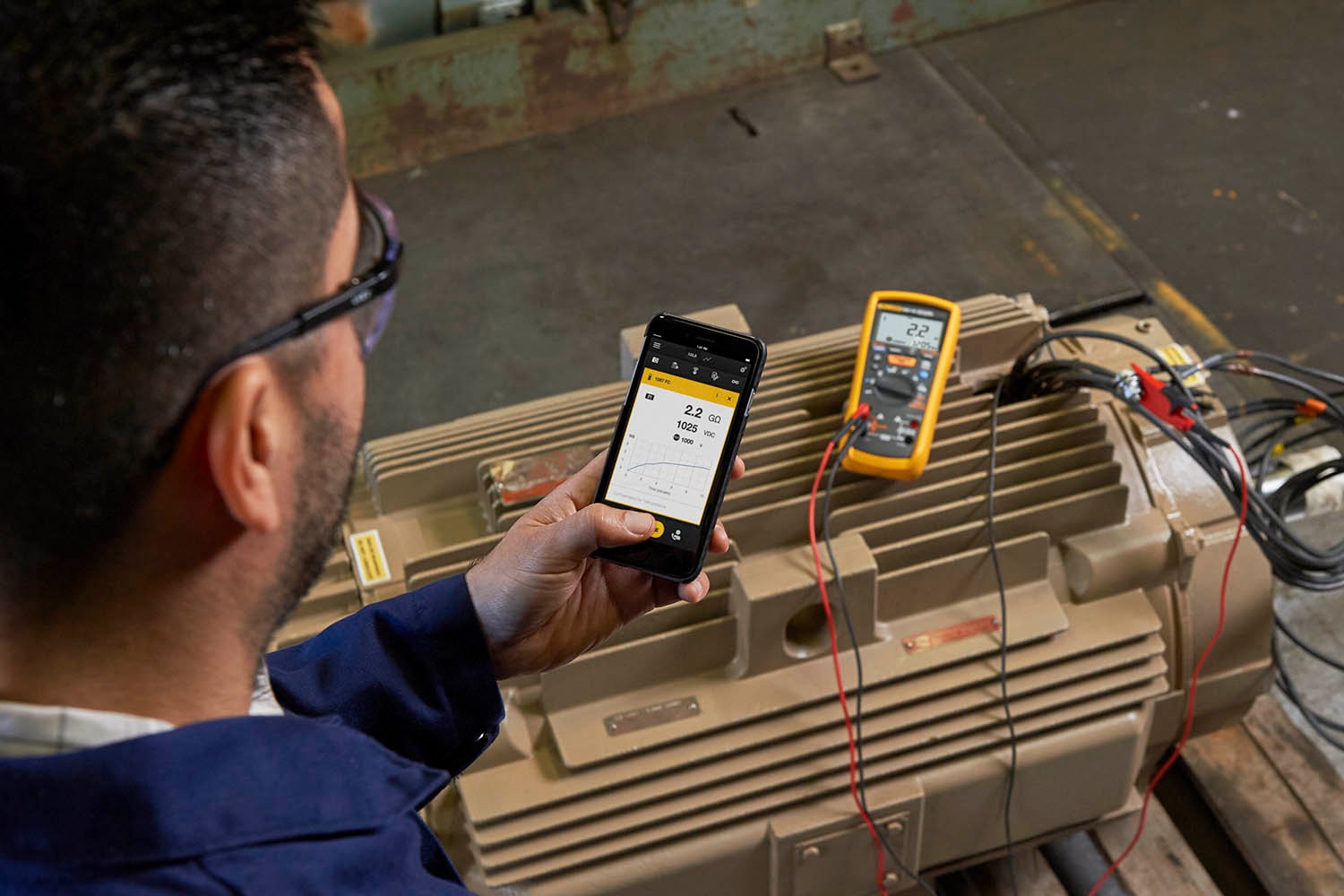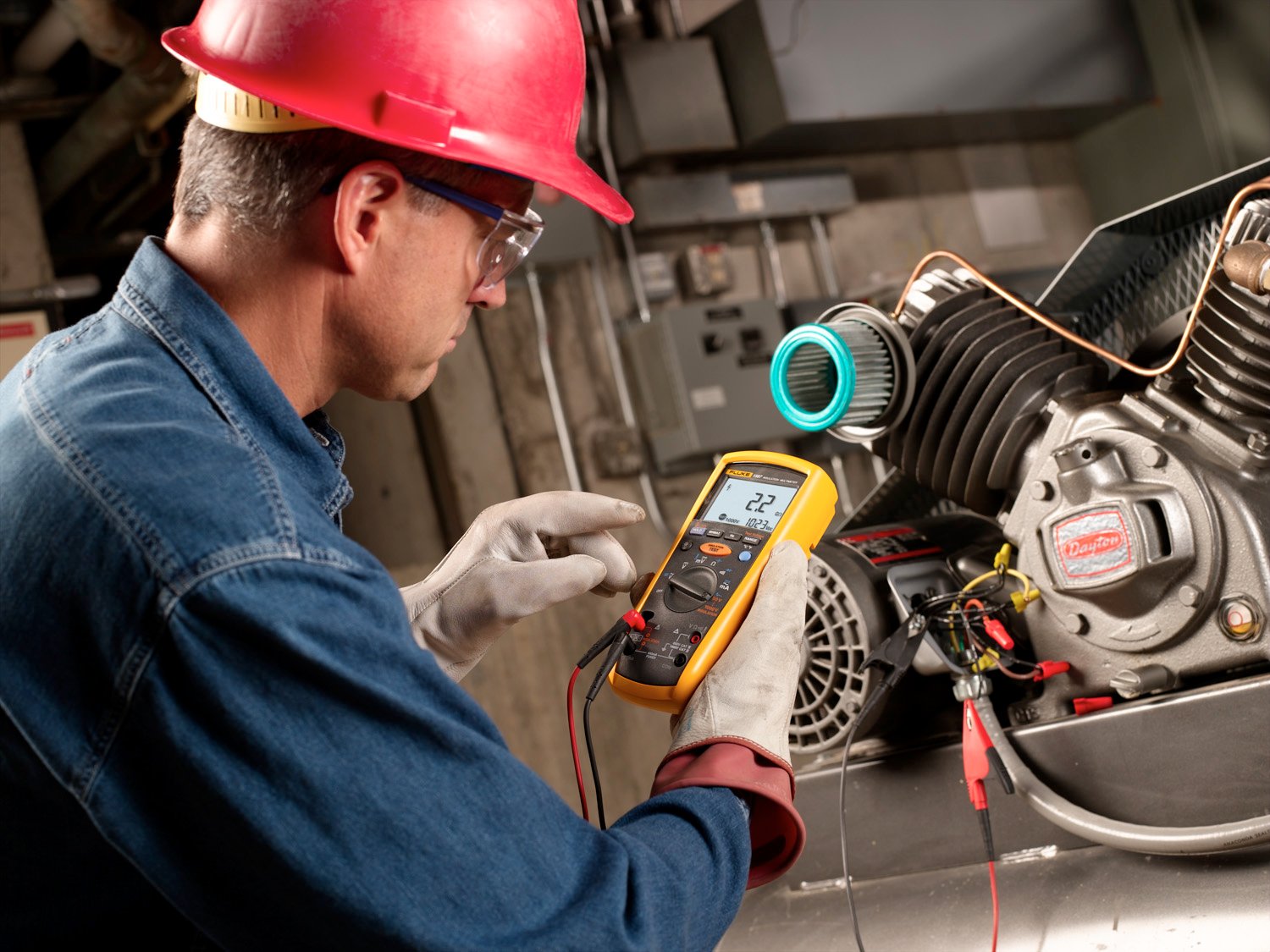HVACR mechanics rarely rely on a single test to pass or fail a function or process. As they walk up to a condensing unit, they listen, they wave their hand over the condenser discharge air, and then they grab the suction line, the liquid line, and the discharge line (and wish they hadn't done that). All of this before they even open their tool box.
Next, they attach gauges and break out thermometers for more exact diagnostics. The more checks and double-checks they have, the better they feel and the closer they come to the truth. When it comes to compressors, insulation resistance testing (IRT), along with refrigerant and oil moisture and acid tests, is another time-proven method that is becoming a standard course of action. An insulation resistance tester supplies “nondestructive” DC voltage to the windings and insulation points of a motor to measure the current leakage rate. There is no perfect insulator, they all leak. But the question is: How much do they leak and is the insulation leak rate changing over time is the insulation leak rate changing over time due to insulation breakdown or contamination? This latter point is the key to predictive maintenance.

At an applied voltage of 500V, this insulation meter reading showed >550 MƱ, indicating resistance is out of range. A second insulation test was performed at 1000 V and showed >2.2 GƱ, indicating no leakage current had been detected.
IRT can check continuity, coil or winding resistances, heating element resistances, thermistor resistance values, and so on. All these measurements are through circuits within the insulators except when checking for a short to ground.
Once a short to ground is detected, a catastrophic failure of the device has occurred, and it is too late for preventive maintenance or proactive remedies. A catastrophic motor failure within a (semi-) hermetic compressor that contains oil and refrigerant at best involves extensive clean up procedure, and at worst may require equipment, rather than component, replacement, as well as lost production time and revenues. Better to regularly check the insulation values and record them for comparison during the next visit, so that any changes are clear.
What insulation resistance values tell us about motor health
There's no hard and fast pass/fail rule for how to interpret insulation resistance values, but manufacturers and agencies seem to agree that IRT trending can be a clear indicator of a motor's projected health.
The IEEE 43 standard for the IR testing of electric motors gives a minimum acceptable value of 1 megohm plus 1 megohm per kilovolt of motor operating voltage. For a 460-volt motor, the pass/fail threshold value would be 1.46 megohms, or a current leakage rate of 500 V dc / 1,460,000 ohms 342 microAmps.
But this standard is for motors that are not hermetically sealed with oil and refrigerant. A motor submersed in liquid may need to use lower values as recommended by the manufacturer. A motor submersed in a liquid may be acceptable at 600,000 ohms with 500 V dc applied, or a current leakage rate of 500 volts / 600,000 ohms 833 microAmps.
Some modern insulations in use since about 1975 have improved insulating values that may not readily allow leakage current and may have IRT values near 20,000 megaohms (20 gigohms) and may be unacceptable for use if IRT values are below 100 megohms, regardless whether they have surface contaminants on the windings or not.

Applying IRT to hermetic compressors is a two-step procedure, due to the nature of the operating environment of the compressor motor.
- Insulation resistance testing to check for degradation of motor winding insulation
- Check for the presence of contaminants that affect the results of IR testing.
The first IR test to trend requires the compressor to have been off, the second test is conducted after the compressor has operated for five or ten minutes. The first test is more likely to expose contaminants within the oil or refrigerant.
The second test, while still affected by contaminants, is geared more toward the true motor IR test, having driven the bulk of refrigerant, oil, and moisture off the windings.
As HCFC's are phased out and replacement HFC's that require the use of POE (polyol ester) lubricants become more prevalent, the importance of IRT for compressors increases due to the hygroscopic nature of the POE lubricants. In addition to moisture indicating sight glasses, oil and moisture sampling reagents or fluids, with IRT, we have another method for estimating moisture within the oil. This is good.
How to test insulation resistance in compressor motors
Never perform insulation resistance testing or operate a compressor when the system is under a vacuum.
- Remove all wiring from compressor terminals to isolate compressor.
- Remove compressor terminal bars if so equipped.
- Clean terminals with a clean, dry shop towel.
- Shunt compressor terminals together if possible. *
- Clean compressor ground location of oxidation and wipe with clean, dry shop towel.
- Measure the temperature of the compressor terminals. Since the temperature of the windings cannot be measured directly, the temperature of the compressor terminals due to direct conduction from the windings is the next best method. Compressor terminals should be above ambient air dewpoint, otherwise moisture on terminals may affect reading.
- Connect ground lead to compressor ground location using provided alligator clip attachment.
- Switch meter to insulation test position and select 500 VDC test voltage.
- Touch test probe to shunted compressor terminals.
- Depress test button on test probe (or on meter) for test duration period (60 seconds).
- Record resistance value and terminal temperature.
- Remove shunt across compressor terminals and restore to proper electrical connections.
- Place compressor in operation for 5 or 10 minutes.
- Repeat steps 1-11.
* Most compressor motor windings have a common connection internal to the compressor, so windings can't be isolated. If motor windings can be isolated, it's preferable to ground two sets of windings while testing the third set. This step would be repeated three times, once for each set of windings. This will not only check for resistance to ground, but also for resistance between the winding under test and the other two windings which tests for an elevated possibility of a short between the windings.
The recorded readings should be logged and compensated for temperature according to the selected baseline temperature. For every 10° C (18° F) deviation above baseline temperature, the resistance value doubles. For every 10° C (18° F) below baseline value, the resistance value halves. If we choose to establish 40° C (104° F) as our baseline value, then all trending measurements, past, present, and future, will need to be compensated to this value.
For temperature compensation, use equation:
KT = (0.5) (TR-TA/10)
Where KT is the temperature correction factor at TA
TR is the reference temperature (°C) to which all measurements are corrected
TA is the actual test temperature (°C)
TR = 40° C
If the reading is beyond the range of the IRT meter scale selection, a "greater-than" (>) symbol will be displayed to indicate that the reading, while it should be recorded and logged to track future changes, has no value for trending purposes. With some modern insulations, it is not unreasonable to expect that through most of the life of a motor, the readings will be off scale (> 2000 MƱ) and trending will only be possible toward the end of the service life of the motor. In this case, the point at which effective megohm values are seen, clean up procedures should be considered.
The following example shows uncompensated test resistance values and the resistance values compensated for estimated winding temperature compensated to a base value of 40° C. The two graphs that follow show the uncompensated trend data compared to compensated data.
| Date | Measured Insulation Resistance (MƱ) | Temperature (°C) | Temperature Adjusted Insulation Resistance (MƱ) | Temperature Compensation Factor KT |
|---|---|---|---|---|
| 5-Feb-2013 | 1584.3 | 42 | 1821.9 | 1.15 |
| 8-Jul-2013 | 1025.3 | 48 | 1784.0 | 1.74 |
| 14-Feb-2014 | 1867.2 | 39 | 1736.5 | 0.93 |
| 2-Jul-2014 | 1388.4 | 43 | 1707.7 | 1.23 |
| 10-Feb-2015 | 2035.3 | 37 | 1648.6 | 0.81 |
| 3-Jul-2015 | 1156.4 | 45 | 1630.5 | 1.41 |
| 4-Feb-2016 | 1503.2 | 41 | 1608.4 | 1.07 |
| 8-Jul-2016 | 1224.3 | 43 | 1505.9 | 1.23 |
| 12-Feb-2017 | 1604.9 | 39 | 1492.6 | 0.93 |
| 1-Jul-2017 | 1123.6 > | 43 | 1382.0 | 1.23 |
| 14-Feb-2018 | 821 | 47 | 1330.0 | 1.62 |
| 10-Jul-2018 | 1245.7 | 40 | 1245.7 | 1.00 |
Why regular IRT is a maintenance best practice
While HVACR mechanics appreciate "Go", "No-Go" rules to apply into their diagnostic routines, the axioms of technology (contemplate entropy) require that a machine begins its final state of failure from the moment it is put into production.
As maintenance and attention to detail increases, so may we expect the probability of the life of a product to increase. As the costs of failures increase, the advantages of regular testing and tracking those measurements over time increase. What about a reading of "Infinity"?
Infinity is not a reading. Infinity means the test results are beyond the range capabilities of the meter. Using a standard volt-ohm meter with less than 9 V dc output, a reading between compressor common and ground may indicate "Infinity." Using an insulation resistance tester with a 500 V dc output the reading between compressor common and ground may be 20 megohms. Consider one of the best natural insulators...the atmosphere. If a high enough potential exists with a difference in polarity, electricity will arc the gap. Consider spark plugs. Consider lightning.
Factors affecting insulation resistance and compressor lifespans
Failure to properly dehydrate a system
- The hydrolysis of moisture with refrigerant can result in hydrofluoric acid. Hydrofluoric acid can etch glass. What can it do to the insulation on the motor windings?
- Acid can erode copper from the tubing walls. This copper is conductive and will reduce the dielectric (non-conductive) strength of the oil. Copper plating can also occur on the motor bearings and eventually contribute to hard starting, higher operating amperages, or a locked rotor condition.
- Moisture in the presence of POE lubricants will be absorbed.
Failure to ream tubing prior to assembly
- This can result in copper shavings in the compressor oil. Copper is conductive and reduces the dielectric of the oil.
Failure to displace oxygen with an inert gas such as nitrogen or argon during the brazing process
- Copper oxides are conductive and will reduce the dielectric of the oil.
Refrigerant leaks
- Low refrigerant charge results in elevated operating temperatures of the motor and stresses the insulation of the motor windings.